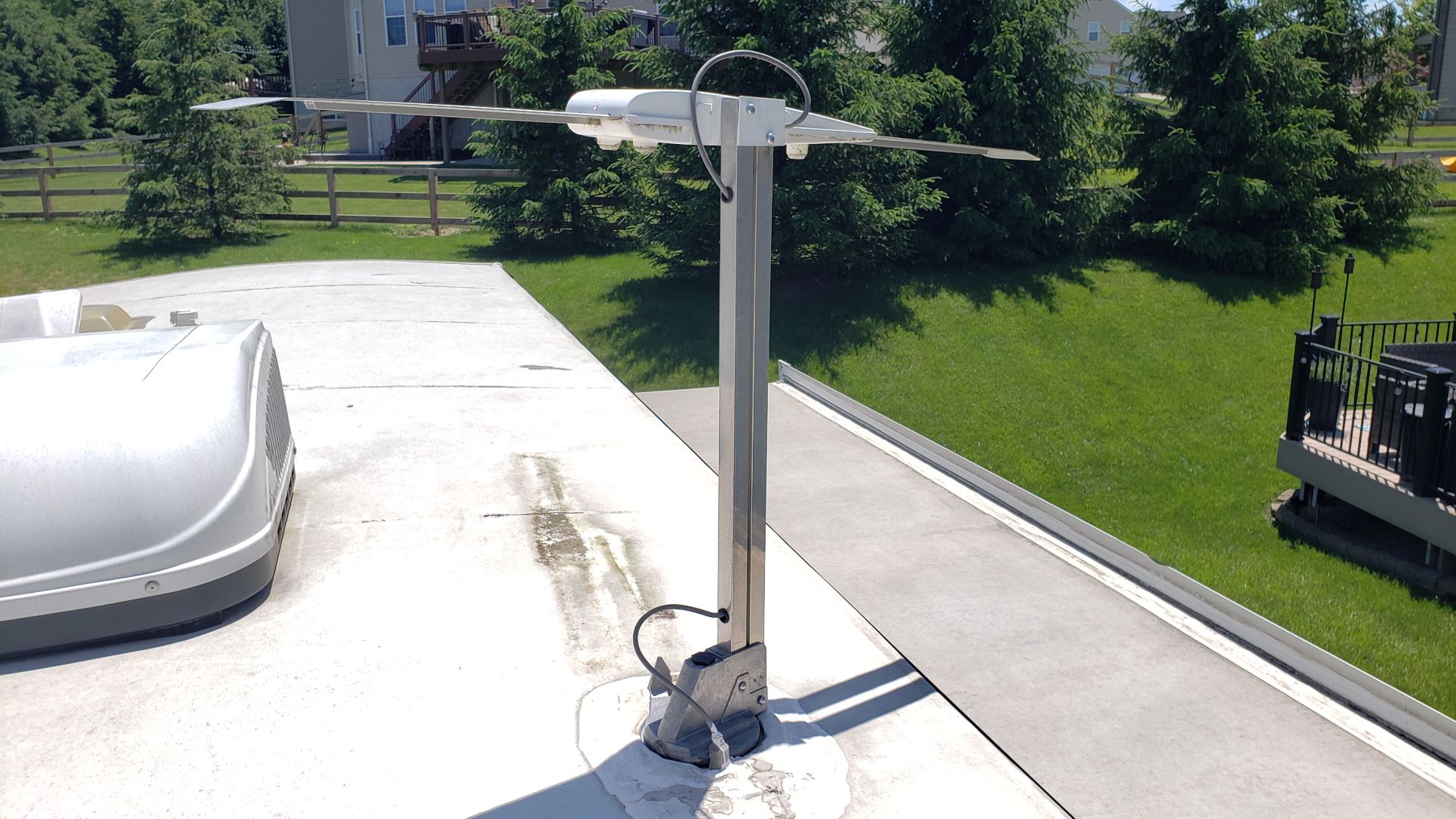Radio can sometimes seem outdated with Bluetooth devices, mobile phones, and music streaming services. Yet, anyone stuck in a digital dead zone can attest to the superiority of FM/AM radio service. As with all RV equipment, though, there comes a time when you’ll have to replace your RV’s radio antenna. This can be tricky to get right and takes patience.
The exact process of replacing an RV radio antenna will depend on the type of vehicle you’re currently driving. Some RVs have side-mounted radio antennas, which pull out of place. If you have a top-mounted radio antenna, you may have to remove a plastic nut from the base of the antenna before rotating it from the mounting flange.
In this guide, I will walk you through the general process of replacing an old RV antenna. I’ll also share some essential tips to make your life easier and help you set the antenna right. If you’re ready to enjoy the sounds of the radio waves, let’s get started!
Don’t forget to check out our Recommended RV Equipment list!
How to Remove an RV Radio Antenna
There aren’t many people listening to the radio in this day and age. Understandably, radio antennas often go without maintenance, and, in time, the mounting systems and metal bases corrode, causing damage to the rest of your RV. If you have recently discovered that your radio antenna is cracking the outer membrane, now’s the time to remove and replace it.
To remove an old RV radio antenna, follow these steps.
- Locate the radio antenna –Older RVs usually have top-mounted antennas, but it’s easy to confuse your radio and TV antenna. The radio antenna will look more like a standard wire, whereas the TV antenna will look like a flat wing. If you cannot find a radio antenna on the top of your RV, look for a small shark-fin antenna on the side of your RV.
- Unscrew the mounting bolts – If your antenna is side-mounted, it will likely have two small bolts holding it in place. Use a socket wrench to remove these bolts. If your antenna is top-mounted, you may have to remove a plastic nut from the base of the antenna.
- Rotate the antenna – With the bolts removed, you should be able to rotate the antenna from the mounting flange. If the antenna is stuck, try wiggling it back and forth until it loosens.
- Inspect the antenna – Once the antenna is removed, take a close look at it. If the base is corroded or the metal is bent, you’ll need to replace the antenna.
- Inspect the mounting flange – If the mounting flange is rusted, you may be able to clean it up with a wire brush. If the flange is severely corroded, you may need to replace it. Now that you know how to remove an old RV radio antenna let’s talk about how to install a new one.
How to Install an RV Radio Antenna
Installing a new RV radio antenna is easy, but there are a few things you need to do to set it up correctly. Here are a few tips to make the installation process easier:
- Choose the right antenna – Not all antennas are created equal. If you live in an area with weak signal strength, you’ll need to invest in a high-quality antenna. If you live in an area with strong signal strength, you can get away with a cheaper antenna. Do some research and find the highest quality antenna you can find in your area to get the best results
- Connect the antenna to the radio – Most antennas have a small wire that connects to the back of your radio. If your antenna doesn’t come with a wire, you can purchase one at your local hardware store. Older RVs may have a different connection, and, if so, try finding an antenna that matches. Otherwise, you’ll have to rip the entire wire out and install a new one.
- Place the antenna on the mounting flange – Once the antenna is connected to the radio, you can place it on the mounting flange. If you’re using a side-mounted antenna, ensure the bolts are in place and tightened down. If you’re using a top-mounted antenna, make sure the plastic nut is in place.
- Test the antenna – Once the antenna is in place, you can test it out by turning on your radio. If you’re not getting a strong signal, you may need to adjust the antenna. Often, top-mounted antennas struggle to pick up AM signals because your roof is likely made from wood. Your antenna will not pick up a strong AM frequency without a metal base.
- Adjust the antenna – If you’re not getting a strong signal, you can try adjusting the antenna. You can try rotating it until you find a sweet spot for a side-mounted antenna. You can try moving it up or down for a top-mounted antenna until you find a sweet spot. Be careful when driving under overhangs not to break your antenna.
With the antenna installed and adjusted, you should be able to enjoy the sounds of the radio waves once again.
A Few Tips to Make Your RV Antenna Replacement Easier
Although removing and replacing an RV radio antenna is pretty straightforward, setting it so that the signal is just right can take some patience and adjustment. To help make your life a whole lot easier, here are a few things to keep in mind:
- Disconnect and reconnect the power – If you’re doing anything more than simply unscrewing the antenna from its mounting flange, be sure to disconnect the battery for safety. After the new wiring is in place, you can reconnect the power before testing the antenna.
- Don’t overtighten the bolts – If you’re using a side-mounted antenna, don’t overtighten the bolts. Just make sure they’re snug. If you overtighten the bolts, you risk stripping the threads. Stripped bolts will loosen over time, causing leaks and crack in your RV’s outer membrane.
- Don’t forget to test the antenna – This should go without saying, but once the antenna is installed, make sure to test it out. If you’re not getting a strong signal, you may need to adjust the antenna. If you cannot get a clear signal no matter how you position it, continue reading below. I’ll cover a few alternatives to help you get better reception.
- Don’t be afraid to ask for help – If you’re having trouble installing the antenna or finding a solid signal, don’t be scared to ask for help. The people at your local RV dealership or hardware store should be able to help you out. It’s always better to get a second opinion before damaging your RV or injuring yourself.
So, with these tips in mind, you should be able to install your new RV radio antenna with ease. However, if you cannot get a clear FM or AM signal, you may have to ditch the standard radio antenna and continue to the next step.
Connect Your Radio and TV Antenna
It’s not uncommon for RV owners to complain that they cannot get AM radio channels. Even if they can get decent FM coverage, their radios refuse to pick up AM signals. If you’re struggling with this problem, your best bet is to connect your radio to the TV antenna. You’ll need a special adapter called a splitter that allows you to connect both devices.
You’ll also need some coax cable to hook everything up. If possible, check the back of your FM/AM radio and look for a fitting that matches the coax attachment on your television. It should look like a copper-toned bolt with a small hole in the center to accept a coax cable. If your radio does not have this fitting, you’ll need an additional matching transformer.
The matching transformer will act as an intermediary between the two screws on the back of your FM/AM radio and the coax cable. Attach one end to the coax fitting, and then slide the clips on the transformer under the screw connector on your FM/AM radio. Once connected, you can then attach the radio to the splitter, and you should receive a much clearer radio signal.
Be sure to disconnect your RV’s battery while going through these steps, especially if you have to disconnect the radio. Even if your radio is turned off, it can still receive a current from the battery if it’s still plugged in.
The Bottom Line
Replacing an RV radio antenna is relatively straightforward, but getting the antenna positioned just right can be tricky. I’ve shared a few tips to help you remove and replace your RV radio antenna in this guide. I’ve also shared a few tips to help you set the antenna up correctly. If you’re having trouble getting a clear signal, you may need to try a different type of antenna. With a bit of patience and some trial-and-error, you should be able to find a clear signal in no time.
Don’t forget to check out our Recommended RV Equipment list!
Get a FREE copy of the Go Together Go Far Travel Trailer Hookup and Disconnect Checklist when you sign up for the Go Together Go Far Newsletter!
Want to learn more about different types of RVs? Check out:
- Best Off-Road Camper Trailer Under $10,000
- Best Bunkhouse Travel Trailer Under 30 Feet
- Are Lance Travel Trailers Any Good?
- Do Rope Lights Deter Rodents?
- What Are the Best Names in the RV Industry?
- 3 Best Travel Trailers for Family of Four
- Blue Ox SwayPro Basics: Top Questions Answered
- Adding A Washer Dryer To Travel Trailer? What You Need To Know.
- Best Drone For Camping, Backpacking, and RVing: A Complete Guide to Drones for RVers
- Furniture and RVs – How To Get It Through the Door…
- How To Get Rid Of A Poop Pyramid In RV Black Tank
- Do You Know How Long To Keep Fresh Water In RV Tank Storage?
- What Is The Best Outdoor Security Camera System For Your RV?
- RV Bumper Mount Grills: 5 Best Options For Your RV Or Camper
- Best Electric Tankless Water Heater for Your RV. What You Need To Know
- Read Before You Buy! How to Find the Best Scooter for RV Camping
- 3 Best Travel Trailers for Family of Four
- Top RV Brands: What Are the Best Names in the RV Industry?
- Lance Campers: What Makes Them So Different?
- Best Bunkhouse Travel Trailer Under 30 Feet
- Best Off-Road Camper Trailer Under $10,000
- Best Weight Distribution Hitch With Sway Control For Travel Trailers in 2022
- What Are The Best Built Travel Trailers? Things To Consider.
- How Does An RV Refrigerator Work? A Quick Guide.
- Why Does My RV Carbon Monoxide Detector Keep Beeping? A Quick Guide.
- Where Is The Power Converter In My RV Or Travel Trailer
- What is the Best Generator for 50 Amp RV?
- Wireless RV Security Camera Systems: Is Solar Powered Security Without Wi-Fi An Option?
- Best Portable Air Conditioner for Camping for 2022
- How to Find the Best 3500 Watt Inverter Generator for RV Camping
- Best Propane Generator For Your RV: Read This Before You Buy!

